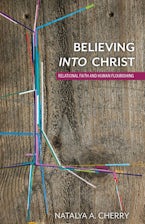Across lines of tradition and denomination, many Christians express a purely propositional sense of belief, focused primarily on the existence of God and facts about Christ, contributing to a transactional approach to salvation. But belief is about more than the simple fact of God’s existence. Augustine provides a starting point for restoring the relational sense of belief encapsulated in the phrase "believing into Christ."
In Believing into Christ, Natalya Cherry explores this unique, grammatically awkward phrase that Augustine recognized and identified in his preaching as describing Christianity’s distinct contribution to human flourishing. Around this idea, Augustine established and systematized a three-part formula for belief, one which his theological successors treated as defining Christian faith. Cherry tracks the origins of "believing into Christ" and its loss in translation. She then crafts a constructive theology that addresses how to restore the phrase and all it entails. Such a view of belief involves transforming catechesis and sacramental practices that can equip believers to overcome oppression and social barriers in contemporary ecclesial communities and the world they inhabit.
Questions regularly arise about how one can believe in a loving God while being complicit with, or actively participating in, systems of violence and oppression. Christian faith informs our resistance against those systems when we practice the bold surrender engendered by believing into Christ. In this way, Cherry challenges us to consider the relational sense of belief, clinging to Christ by means of the Holy Spirit in a way that directs every relationship toward human flourishing, as the heart of Christian faith.

